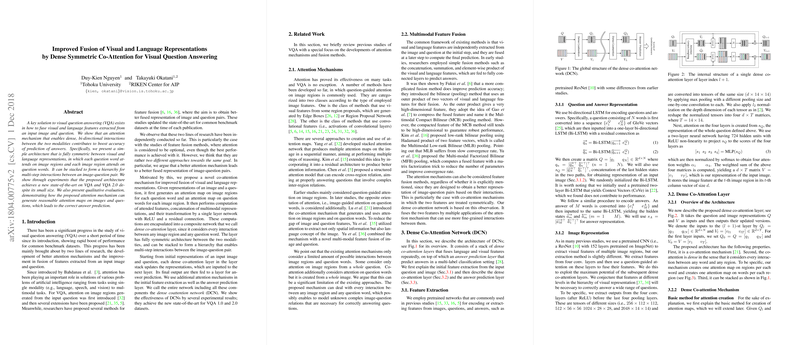Improved Fusion of Visual and Language Representations by Dense Symmetric Co-Attention for Visual Question Answering
In the paper "Improved Fusion of Visual and Language Representations by Dense Symmetric Co-Attention for Visual Question Answering," Nguyen and Okatani propose a new architectural approach to the visual question answering (VQA) problem. The focus of the paper is an innovative method of fusing visual and linguistic features through the introduction of a dense, symmetric co-attention mechanism. This approach enhances the interaction between visual and textual information, ultimately leading to improved accuracy in VQA tasks.
Architectural Insights
The proposed solution, the Dense Co-Attention Network (DCN), seeks to address two key facets of the VQA challenge: feature fusion and attention mechanisms. The architecture is designed to enable bi-directional interactions between a visual representation of an image and the linguistic representation of a question. It leverages a dense co-attention mechanism that factors in every interaction between word and image region pairs, moving beyond existing methodologies that consider only limited interactions or use attention in a single direction.
This dense co-attention is achieved through a composite network layer that is fully symmetric, allowing each image region to attend to each question word and vice versa. The network is stackable, forming a hierarchy of dense co-attention layers that promote multi-step interactions, progressing iteratively through the network to refine the image-question representations continuously.
Experimental Evaluation
The DCN was rigorously tested against the VQA 1.0 and VQA 2.0 datasets, establishing a new state-of-the-art in terms of accuracy. One of the standout features of the network is its compact size relative to its predecessors, showcasing the efficiency of the proposed attention mechanism. The architecture achieved remarkable results across different question types, most notably in the "Number" category, highlighting its capacity to model complex relations inherent in VQA tasks.
Implications and Theoretical Contributions
The dense co-attention mechanism proposed in this paper exemplifies a significant step forward in the integration of visual and linguistic data. By allowing exhaustive pairwise interactions and maintaining a symmetric structure, the DCN can better capture the underlying dependencies necessary for nuanced understanding in VQA tasks.
On a theoretical level, this work provides a robust framework for exploring multi-modal fusion via dense connectivity. It challenges the community to rethink attention mechanisms, suggesting that increasing interaction granularity can lead to tangible improvements in performance.
Potential Future Directions
Considering the success of DCNs, future work could explore scaling this methodology to other multi-modal tasks requiring fine-grained feature integration beyond VQA. Furthermore, integrating other forms of contextual information or extending the hierarchical structure to deeper levels could enhance the network’s capability to generalize complex reasoning tasks. Additionally, the exploration of the network's adaptability to other datasets or its combination with reinforcement or unsupervised learning paradigms may yield further insights.
In conclusion, the paper by Nguyen and Okatani makes a notable contribution to the field of VQA and multimodal AI systems. By pioneering a dense symmetric co-attention mechanism, the authors not only advance the state-of-the-art in VQA but also open new avenues for research into synergistic fusion of visual and linguistic data.
